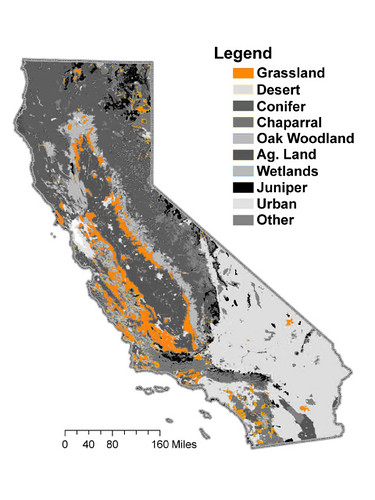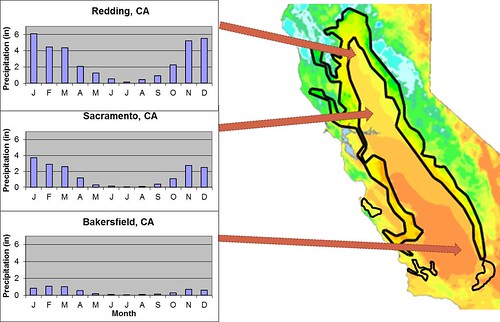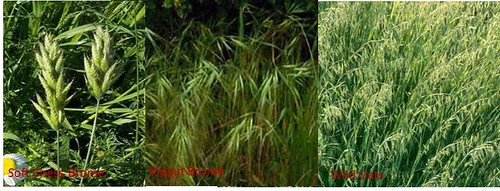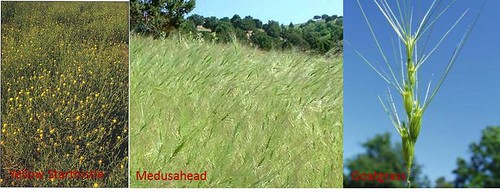California is home to a unique grassland dominated by annual grasses and forbs that replaced the native flora during European colonization of California. This annual grassland occurs in a ring around the Central Valley and along the Coast Range, often intermixed with oak-woodlands and chaparral. Much as California's Central Valley is home to one of the most diverse and productive agricultural regions in the world, the annual grasslands are home to diverse plant and animal populations. This grassland covers about 7.1 million acres.
California is home to a unique grassland dominated by annual grasses and forbs that replaced the native flora during European colonization of California. This annual grassland occurs in a ring around the Central Valley and along the Coast Range, often intermixed with oak-woodlands and chaparral. Much as California’s Central Valley is home to one of the most diverse and productive agricultural regions in the world, the annual grasslands are home to diverse plant and animal populations. This grassland covers about 2.9 million hectares (7.1 million acres).

Climate
The climate of the annual grasslands is Mediterranean, with precipitation falling primarily between October and May, mostly as rain (Fig. 2). The dry season averages 6 months but may range from 2 to 11 months. The frost-free season averages 250 to 300 days annually.
Average annual rainfall decreases from north to south with Redding, CA, receiving 82.5 cm/yr (33″/yr), Sacramento receiving 44 cm/yr (17.5″/yr) and Bakersfield receiving 16.25 cm/yr (6.5″/yr).
Winter precipitation is primarily the result of cold fronts that move across the Pacific Northwest and northern California. The frequency of these storms decreases from north to south. Rainfall in California ranges from less than 25 cm (10″) in southern desert areas to more than 250 cm (100″) on the north coast. On average, foothill oak-woodland precipitation range is 38-82 cm (15-32″).
Each growing season starts when rainfall is sufficient to germinate stored seed. Young annual plants then grow rapidly if temperatures are warm (15.6° to 26.7°C or 60° to 80°F), but more slowly if cooler temperatures prevail (4.4° to 10°C or 40° to 50°F ). There is little growth during winter when temperatures are low (4.4°C or 40°F or below). Rapid spring growth begins with warming conditions in late winter or early spring. Rapid growth continues for a short time until soil moisture is exhausted. Peak standing crop occurs at the point when soil moisture limits growth or when plants are mature.
Topography and Soils
California’s annual grasslands occupy flat plains to gently rolling foothills, so soils and topography vary greatly. Annual grassland watersheds are predominantly drained by intermittent streams that only flow during the wet season. These intermittent streams feed into higher-order permanent streams and eventually to Central Valley or coastal rivers. Several inches of rainfall are needed to saturate the watershed and cause intermittent streams to flow, and in dry years these intermittent streams may not flow at all.

Current Plant Communities
Most of California’s annual grasslands are dominated by non-native grasses and forbs of Mediterranean origin introduced and established during European colonization. The invasion continues today.
Major Plants
Introduced annual grasses are the dominant plant species in the annual grasslands. These include wild oats (Avena fatua and A. barbata), soft chess (Bromus hordeaceus, formerly B. mollis), ripgut brome (Bromus diandrus, formerly B. rigidus), red brome (B. madratensis, formerly B. rubens), wild barley (Horedeum spp), and foxtail fescue (Vulpia myuros). Common forbs include broadleaf filaree (Erodium botrys), redstem filaree (E. cicutarium), turkey mullein (Eremocarpus setigerus), true clovers (Trifolium spp), bur clover (Medicago polymorpha), popcorn flower (Plagiobothrys nothofulvus), and many others. California poppy (Eschscholzia californica), the state flower, is found in the annual grasslands. Native grasses, such as purple needlegrass (Nasella pulchra) and blue wildrye (Leymus glaucus) and native forbs, can be found throughout the annual grasslands. Native perennial grasses are more common on northern sites with mean annual rainfall greater than 150 cm (60 in).

Animals
Of the 694 terrestrial vertebrates (amphibians, reptiles, birds, and mammals) native to California, over 285 species use annual grasslands for reproduction and/or cover. These include at least 97 species of mammals, 130 species of birds and approximately 73 species of amphibians and reptiles. Many of these species are on state or federal threatened and endangered lists.
Many small herbivores (jackrabbits, squirrels, gophers, mice and voles) use the annual grasslands for food cover and reproduction, and in turn serve as food for coyotes, bobcats, reptiles and other predators. More than 100 bird species, including owls, vultures, and meadowlarks, use the annual grasslands, either seasonally or throughout the year.
 Common animals in annual grassland
Common animals in annual grassland
Long-term Trends
Prevailing seasonal and annual weather largely controls the seasonal and annual productivity and species composition, but long-term change in annual grassland productivity, species composition and ecosystem processes has been influenced by continuing waves of invasion. Patterns of soil moisture depletion have changed. Fire frequency has also changed, from frequent burning by Native Americans and early ranchers to infrequent burning today. Frequent fire would have reduced thatch buildup and grass dominance, resulting in a species composition shift toward forb domination.
Yearly and Seasonal Variation
As germination, seedling establishment and plant growth progress during a growing season, species composition changes. This change depends primarily on the timing and amount of precipitation, and the temperature. Consequently, understory and open grassland species composition vary both seasonally and annually. Unlike many perennial-dominated grasslands, kinds and amounts (weight or cover) of herbaceous species are not stable and predictable from year to year. Grass-dominated years occur when rainfall is well-distributed or greater than normal. Filaree years occur in low rainfall years or when residual dry matter is low. Drought, heavy grazing, and fire all result in filaree-dominated understory.
Disturbance Factors
Grazing, crop production, fire, and drought all contributed to the conversion of California’s former native grassland to the current annual-dominated grassland. While livestock grazing has been implicated as a primary reason for this conversion from native to non-native dominance, some recent studies suggest that tillage (cultivation) associated with crop agriculture may have been the primary cause of the conversion.
Severe droughts in 1828, 1862 and 1864 also contributed to the conversion to non-native annual-dominated grassland. At least eight multi-year droughts have occurred in California since 1900. Droughts that exceed three years are uncommon, though occurrences in the past century include 1929-1934, 1947-1950, and 1987-1992. Some researchers have suggested that high-frequency burning first by native peoples and later by Europeans may have made the former grassland susceptible to invasion by non-native species.
Carbon Sequestration
Without restoration technology to consistently and economically restore deeper-rooted native perennial grasses and forbs, the opportunities to increase the storage of carbon in this ecosystem are limited. The one exception is on sites where tree planting can be successful.
Native Grass Restoration
Needlegrass (Nassella pulchra) and other native perennial grasses occur naturally in this ecosystem, but most attempts to restore native perennial grasses fail due to the aggressive competition from dominant annual grasses and forbs. While there has been some success in restoring native grasses using intensive agricultural practices, restoration failures continue to exceed successes, especially on steep, rocky and/or eroded sites.
Invasive Species
While many of the species in the herbaceous layer are alien species, several are particularly troublesome. These include medusahead (Taeniatherum caput-medusa), barbed goatgrass (Aegilops triuncialis) and yellow starthistle (Centaurea solstitialis).

Land Use Change
Since 1973, conversion to residential and industrial uses has resulted in large annual grassland losses. Conversion of annual grasslands to production of wine grapes and other agricultural products has also contributed to the loss of annual grasslands. This results in increased urban-rural conflicts with farming and ranching operations. It also results in habitat fragmentation and loss of habitat for birds and other species.
Water Quality
Water quality is an issue in the annual grasslands and the oak-woodlands because most of the state’s reservoirs are in or near these ecosystems of the Sierra Nevada foothills: these water bodies are often domestic water sources for urban areas, including San Francisco and Los Angeles. Sediment, nutrients, pathogens and heat are potential water pollutants that may be associated with grazing in annual grassland watersheds.
In 2004, California’s State Water Resources Control Board adopted policies for regulating non-point source pollution. These policies affect landowners and agricultural producers, including range livestock operations. This new policy replaced a voluntary, education-supported program with regulatory programs, such as implementation of total maximum daily load (TMDL) requirements for non-point source discharges from agricultural lands, including grazing land.
Since European settlement, the primary use of North American annual grasslands has been livestock production. More than 80% of the annual grasslands are in private ownership and most is grazed. Orchards, wine grapes and irrigated pasture have displaced some of the annual grasslands in some counties.
Grazing Management Practices
Most of the annual grasslands are suitable for grazing by all classes of livestock at any season. Sierra Nevada foothills and coast range annual grassland carrying capacity is commonly in the range of 4-12 hectares (10-30 acres) per animal unit per year. However, there are dry areas around the southern San Joaquin Valley where up to 40 hectares (100 acres) may be required to support an animal unit for one year. Additionally, forage quality declines below the nutritional needs of many kinds and classes of livestock during the 6-8 month dry season.
Forage Sources and Seasonal Use
Each ranch has a different mix of forage sources to support production. Forage sources are seasonal in their availability, productivity and quality. The annual grasslands and oak woodlands are the largest source of grazed forage in the state. Season of grazing is controlled by seasonal availability and lease agreements.
Because they are dominated by annuals, these rangelands begin to grow with fall rains. They grow slowly during the winter and then have a burst of production when temperatures warm up, starting in late February and early March. Standing crop reaches its peak in April or May, followed by soil moisture depletion and onset of the dry season. Thus, they provide green feed in late fall, winter, and spring, and low-quality dry feed the rest of the year. Traditionally, ranches have moved livestock to high elevation public and private rangelands or irrigated pasture during the summer to keep livestock on high-quality forage. Many ranches provide supplements to livestock on annual range when green forage is in short supply.
Grazing Systems
Continuous grazing and seasonal-suitability grazing are commonly used on annual rangelands. These grazing systems are the result of research and adaptive management (trial and error) over several generations. There is some speculation that desirable plants, particularly grasses, will be grazed excessively under continuous grazing. However, research does not support this view when proper stocking rate is implemented. With continuous grazing, stocking rate must be very light during the growing season because adequate forage must be left to carry animals through the dormant season. Under light stocking, animals are allowed maximum dietary selectivity throughout the year. For example, cattle and sheep preferentially select forbs (i.e., broad-leaved plants) during certain times of the year, which can greatly reduce grazing pressure on grasses. Rotation systems that restrict livestock from part of the range during the growing season can waste much of the forb crop because some forb species complete their life cycle quickly and become unpalatable after maturation. In these cases, the forbs have dried up and even shattered by the time some of the pastures are grazed in the rotational grazing system.
Animal Nutrition and Forage Quality
Matching the nutrient demands of livestock with the nutrients supplied by range forage is a balancing act for a considerable portion of each year. The quality of range forage varies with plant species, season, location, and range improvement practices. Range forage is optimal for livestock growth and production for only a short period of the year. Early in the growing season, forage may be of high nutrient content, but high water content in the forage may result in rapid passage through the rumen and incomplete nutrient extraction.
Poisonous Plants
Several poisonous plants are present in the annual grasslands, although cattle losses to poisonous plants are rare. Livestock poisoning is often a result of hungry animals being concentrated on toxic plants. Yellow starthistle (Centaurea solstitialis) is poisonous to horses. Pyrrolizidine alkaloids in fiddleneck (Amsinkiaspp.) can cause liver damage in livestock. Several milkweeds (Asclepias spp) may be found on this ecological site, including Mexican whorled milkweed. Milkweeds contain several glucosidic substances called cardenolides that are toxic to range livestock. Larkspur (Delphiium spp.) may be present and contains several alkaloids. Cattle consume larkspur most often after plants begin flowering. The leading cause of livestock poisoning in California is from consumption of oleander used in landscaping.
Brush and Weed Control
Successful management of noxious weeds on rangeland requires a long-term multi-year plan that incorporates prevention of invasion as well as control of existing infestations. Practices may include burning, herbicides, mechanical methods, and targeted grazing. Use of prescribed fire has declined due to liability issues and regulatory policies of California’s Air Resources Board. The use of herbicides on rangelands in California is very limited. Often, a critical part of weed control is replacement of undesirable species (following initial control) with more desirable species.
Seeding and Fertilization
Improved forage production and quality can be achieved by seeding annual legumes (rose clover and subterranean clover) and annual grasses such as annual ryegrass. Annual legume production is improved by the application of sulfur and phosphorus fertilizers.
Nitrogen fertilization increases forage and animal production in the 40-80 cm (16-32″) rainfall zone. Rangelands in lower precipitation zones receive too little rainfall for the fertilization to be effective. Rangelands above 80 cm (32″) receive too much rainfall and fertilizer nutrients are leached from the soil. Because annual grassland soils are often sulfur- and/or phosphorous-deficient, these nutrients must be added with nitrogen to achieve increases in production.
Native Grass Restoration
Purple needlegrass (Nasella pulchra) and other native perennial grasses occur naturally in the annual grasslands as widely dispersed individual plants and small isolated stands. Restoration of native grasses has been a recurring objective of range managers on California’s annual rangelands since the 1940s. The goal of restoring grasslands and woodland understories to some pre-European settlement condition has proven to be unrealistic: not only is there uncertainty about the historical composition and extent of California native grasslands, but restoration failure is common (and few showcase their failures). Rangeland and restoration scientists have tried to restore native grasses but have not found dependable native grass restoration practices for use on land that is steep, rocky, and/or highly eroded. On arable land, native grasses can be grown for seed and pasture following standard crop production methods. Scientists continue to seek practices to control the annuals and promote native perennials.
- CALIFORNIA RANGELAND Research and Information Center Information about California rangelands (UC Davis)
- CALIFORNIA RANGELAND WATERSHED LABORATORY Research and outreach on the diverse managed ecosystems (UC Davis)
- CDFG – Biogeographic Data Provides GIS support for all DFG branches
- CRCC California Rangeland Conservation Coalition
- Ecology and Management of Grazing Online Course For-fee online course
- Manual of California Vegetation California Native Plant Society vegetation description system
- Mendocino/Lake Livestock and Range Topics
- Plant Information Information on California plants.
- Rangeland Forage Loss Estimating annual rangeland forage loss
- Rangeland Monitoring Monitoring publications
- Terrestrial Vegetation of California Book on California’s diverse and ever-changing vegetation published in 2007 (Michael Barbour and Todd Keeler-Wolf, eds.)
- Weed Research and Information Center Information on California weeds
